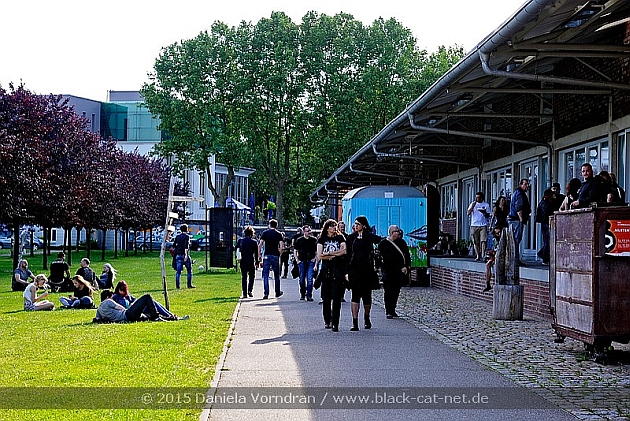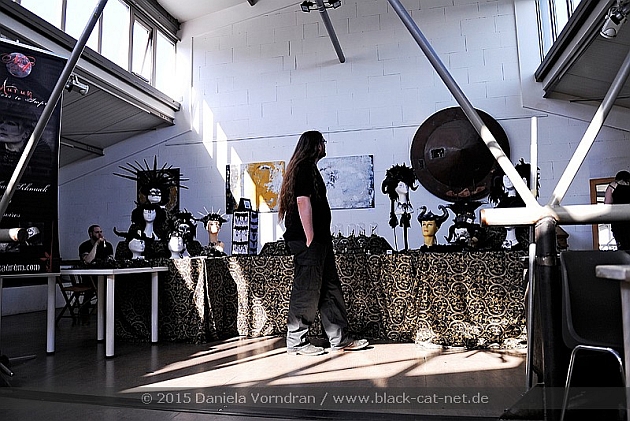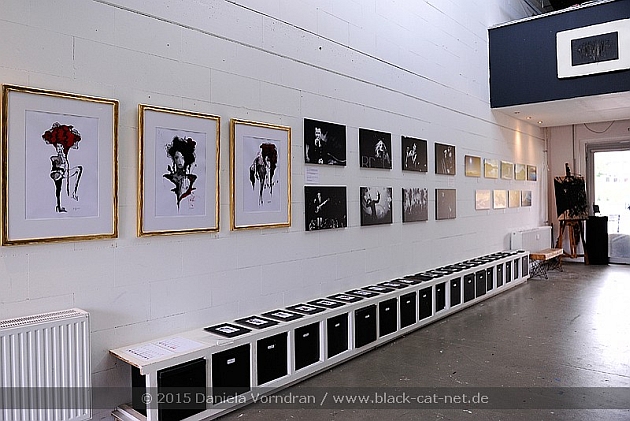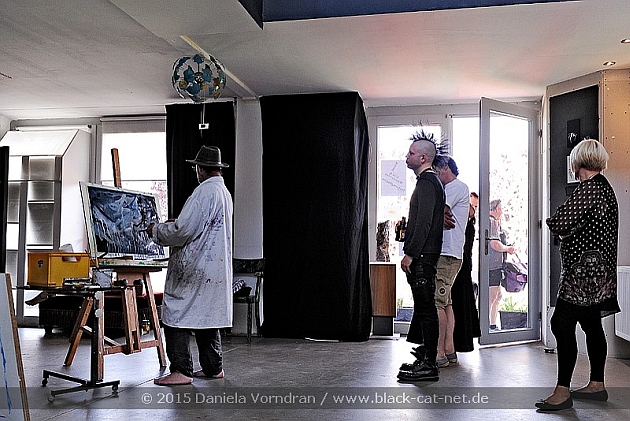 Güterhallen im Südpark, Solingen, Germany
Güterhallen im Südpark, Solingen, Germany27th June 2015
Düsterhallen: Art Festival with Exhibitions and Live Shows by Slave Republic, .com/kill and Architect
In March, 2015 Janine Werner, Christian Licht and Adrian Hates decided to make a gift for fans of dark music by throwing a soiree called “Düstererwachen”. However it turned out to be just a sign of a rise: the organisers announced a new event, a festival they called “Düsterhallen”. During following months the potential visitors were kept posted with information about the content, while the organisers slowly laid cards on the table one by one, and with each one the interest for this new project grew more and more. And finally on 27th of June 2015, Düsterhallen took place in Solingen for the first time.

Actually art had already inhabited that park. For example, there can be found sculptures made from some improvised materials, enormous metal dandelion, scissors, and so on. Contemporary art makes the viewer to think, to imagine, to investigate and to guess. So he or she finds him or herself not in front of an object of art, but inside it, and simultaneously becomes a partaker of a creative process. So such exhibitions are different from usual galleries, where you can just see objects of art. Here everything goes the other way, and each room has its own way of decoration. And so, if the room is decorated with fabric, then so was the author's decision, and perhaps you really should watch the works through this thin, nearly weightless matter. You never know what's waiting right round the corner, while walking through those halls. The mood of presented works may switch from warm and tender to panic and depressive. So it was really good idea to choose a place with small halls of different configuration for Düsterhallen. In some of those halls you had to face the art nose tip to nose tip, and in others you even didn't notice it firstly. So, for example, I noticed part of one exposition only when visited that hall for the third time. The strangeness and obscurity of contemporary art is a truism of nowadays.

Perhaps it is really strange and obscure, but the more you look at a picture, photo or a sketch, the more questions appear. And does art really have to provide any answers? They say a good question contains an answer already. May be contemporary art teaches us exactly to ask questions, while we already have too much answers. Think more, look around, find the relation, it's always there. By the way, here could be seen an example of organisers' excellent work: each object was in the right place, and though different artists' works could be placed in one hall, the harmony remained. Not like we think of this often, but the arrangement of items, the composition of works made in different manners, the light also play an important role. In this particular case the organisers proved themselves able to create works of arts out of objects of art. Each piece showed its own colours and each one was unique, but at the same time they all were complementary, or even contrastive parts of something bigger, and even the contrasts but added flavour. The viewer had to pay attention to detail, and then new sides or even worked of art could be found. For example, you could notice Marcel Lamour's spiders, that were placed near the door. A good joke: at some point it looked like they are really crawling down the wall and are about to reach the door.

So, what about a walk through the halls? In one of them you could see incredible headdresses in a fairy-tale fashion, made of any possible material. It's how art enters everyday life and changes it. In other hall you found yourself in an actual city created by Johen Brillowski's photo works. But they're not like panoramas we're used to. A special technics was used to create an illusion of motion. Among others there were pictures of Cologne and Düsseldorf, and their key words definitely include "motion". You also can mention noise, velocity, fuss, as well as old-time buildings and quiet walks at the riverbank. Johen succeeded in portraying those never-stopping cities' characters. Outdoor in front of one of halls you had a chance to meet a real artist. By the way, what is your idea of how an artist can look like? Just think a little over it. Perhaps you would imagine someone dressed in white, wearing with a beret, all covered with stains of paint? He looked so or like it, and was all into creating abstract portraits in black and blue, sometimes leaving rare strokes of white.

In the next hall you met not less abstract, but much more colourful works of Beatrix Deus. Actually you were presented with an offer to bethink of what you see around. These works don't have any recurring patterns, each one has a temper of its own. It was this hall where visitors could look at the paintings through black cords hanging like louver-boards, and pieces of fabric. Such manner becomes popular, I've already seen it on another exhibition of contemporary art. Perhaps it helps to distinguish space, but yet to observe pictures through those veils seems engaging. And it really grants a new impression, especially when you look through a camera while taking pictures of exhibition. Play of colour and form is a matter of first importance, when it comes to abstract art, and due to it even colours I don't favour gain a new meaning. In one of halls a painting made in acid-green scale of colours evoked associations with cosmic space, field grass and a magic potion simultaneously. Another picture from this hall reminded of Monet's ‘Water Lilies’ from Musée de l'Orangerie in Paris, having the same palette and light summer mood.

Not only painters participated in this event, but photographers as well. In AndersARTig pavilion you could meet real photo art. And while only black and white concert pictures were seen among Daniela Vorndran's works, Silke Jochum's works showed us nothing less than Iceland. Both photographers' works were presented on one wall, and it was fascinating to see such different sides of photography. Here you could witness several contrastive sides: the colour, the main subject, extent of getting close to the subject. The photos are absolutely different, but it's hard to say whether you are attracted more by powerful and emotional concert pictures, or by depictions of calming and eternally beautiful nature of Iceland.

Cold black and white pictures by Norbert Sarrazin, taken in an old hospital, were the easiest for a usual man next door's understanding. However there's something creepy, but attractive about them. If we are talking of photo art, then, as far as I can tell, Sarrazin's works are interesting, because in this case a great emotional response is caused by works quite simple in regards of composition. Here any change of an angle, addition of a darker tone could destroy this cold harmony. When it comes to photo art, it's possible to deliver a message to a viewer by showing a picture of just one item. Shooting actually is not as simple as it is often considered to be. Combination of light, colour, arrangement of items should be perfect and meaningful. A story hides behind every picture. For example, a world-famous photo artist Thomas Ruff, who also lives and works in Düsseldorf, has a series of works depiction interiors. It shows usual rooms, like a bedroom or a bathroom, but let me assure you, that there is nothing usual about it. Surely Sarrazin's works are a better match for a gothic culture festival, though you can see that many photographers work in this genre, let's call it figural.

Among others in AndersARTing pavilion were presented the organisers' works, in particular by artist Janine Werner and musician Adrian Hates. It was interesting to see, how Adrian reveals himself in his abstract art. While we are already familiar with Marcel Lamour's works via booklets of DIARY OF DREAMS albums, Adrian's works were to be shown for the first time. In my opinion to show a new side of your creativity, one so different from what's expected from you, to show how you see this world not through lyrics and music, but through colour, material and form was quite a bold move. Risky one, but well-taken. Several works of this musician, gathered together on one wall, made quite a powerful impression. Well-set lightning, the right arrangement of works , even the background helped to create the whole impression of cohesiveness, while enhancing the senses, and accentuated the texture of volume installations. For me Adrian's art looks like his music in a way. It is like telling a story without any facts, with just ideas, thoughts, paths. Tri-dimensional objects of art, combining different materials and textures, are always a mind teaser, a choice of a way. A thread was extended through many works, somewhere it had a beginning, somewhere it was interrupted, but there was no way to say for sure, how actually this new abstract artist's hand had moved. All works were linked, there could be a mutual tune, but absolutely different stories hidden behind them. In the centre of one composition was a symbol that looked familiar. It reminds of an image used in a booklet for DIARY OF DREAMS MCD ‘Giftraum’, doesn't it? Adrian seems to put something very important into it.

Nearby, on the next wall were presented several works by Marcel Lamour. This hall rally revealed his works' character: they could be wherever but not in the centre. Such concept seemed to be suitable, because it allowed us to see Marcel not as a painter, who works in that or this certain style. When a jagged canvas, looking like an imprint of some dark force, catches your attention, you come closer to discover the artist's name, and it turns out to be Marcel Lamour, the one who's already known to you as an author of elegant lines leaving an illusion of motion. Sketches made with ink looked like a play of lines. Here you can't but think that they'll change their ways, if you turn away, thus changing the whole meaning. Bright white lines and coal-black paper seemed to be a method to imprint evanescent emotions. One even could make a puzzle out of them. It should be noted, that in this hall near Adrian's and Marcel's works soft sounds of music could be heard. It was a perfect match. Sound, colour, light, texture made you observe the artworks sharper and created not just a set of art-objects for witnessing by eyesight, but an art-space for a whole sense system.

Along with the exhibitions the program included poetry slam and fashion-show, but unfortunately I didn't have a chance to see them. But at 20:00, or, more precisely, half past eight, 'cause it's not stylish to enter the stage in time, SLAVE REPUBLIC finally started their gig. In my opinion the live version is better than studio one. This time Daniel Myer performed along with them, making himself a matching part of the whole thing. The technical side also was excellent despite the smallness of the hall where the performance took place. Not a lot of people were there at the beginning of the musical part, perhaps the whole quantity didn't lessen, but outdoor it was easily to tell how much dark-clothed people were there. I can't say there was a very emotional response, though that doesn't mean the performances weren't fancied, but quite the opposite. There were a lot of DIARY OF DREAMS and .COM/KILL fans among the visitors t, that was obvious thanks to T-shirts with logos of Adrian Hates' projects. In a way it was a means to express gratitude and support.

After SLAVE REPUBLIC, .COM/KILL entered the stage. This band's performance was harsh, powerful, rough just as their music. Their setlist doesn't change a lot because only one album exists to the point, but that doesn't make their live shows less fetching. They really can give a good lesson, how to charm music with emotions, and how to play with sound and performing. After one of songs Gaun:A thanked the public for coming and reminded: “Today we are not at a concert, but in an artistic workroom”. The enthusiasm grew with every song, and when ARCHITECT entered the stage, the audience already was on fire. Daniel Myer's performance also was greeted very warmly. Intense vibrant tracks with a lot of additional soundings, a little bit too sharp turns made an interesting effect. Later an after party, where Adrian Hates and Daniel Meyer performed as DJs, started. The music really met the audience's mood, so the dance floor was never empty till 3 a.m. After the last track the audience's gratitude was expressed through applause and loud sympathetic “Super”-s and “Danke”-s.

All in all, Düsterhallen has a future. Ex-warehouse, placed in a small park, is not yet ready for an ample quantity of visitors, but the park itself allows to host more wide-spread events. There's also a green area, where a stage for an open air can be set. Also there's a little cafe, and within walking distance there is a railway station Solingen Mitte. S7 train can be caught there nearly twenty-four-hour, so it's always possible to take a ride to centre of Solingen or even to Düsseldorf, and at the same time there's an option to stay at some hotel nearby. Nothing should get in Düsterhallen's way of becoming a large festival with a long history. A great thanks to the organisers, who managed to gather different kinds of dark art under this roof. So, see you here in 2016?

Written by Ksasha Lionceau for the official Russian Diary of Dreams Fan page “the Valley”, Translated into English by Alra Alrolemur
The Russian version of the article is available here: http://www.diary-of-dreams.ru
All Pictures by Daniela Vorndran (http://www.vorndranphotography.com / http://www.facebook.com/blackcatnet)




